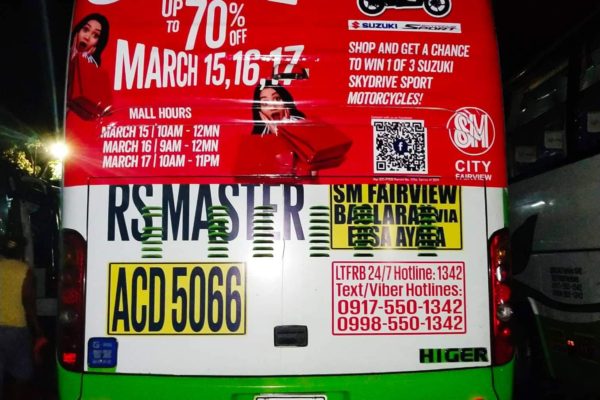Make The Most Of Direct Exposure with Transit Advertising Philippines
Make The Most Of Direct Exposure with Transit Advertising Philippines
Blog Article
Recognizing the Function of Transportation Marketing in Enhancing Brand Exposure and Customer Engagement
Transportation advertising and marketing has actually arised as a critical component in the marketing landscape, using one-of-a-kind opportunities for brand names to raise their exposure and involve consumers successfully. With the capacity to reach a diverse and restricted target market throughout their daily commutes, these advertising strategies are not simply about exposure; they have to do with developing meaningful connections with prospective clients. As we check out the complex advantages and cutting-edge strategies within transit marketing, it ends up being crucial to consider how these elements collectively influence consumer perception and behavior, raising questions about their lasting effect on brand name commitment.
Meaning of Transit Advertising And Marketing
Transit advertising and marketing refers to the method of promoting items, services, or brands via promotions put in and around public transport systems. This kind of advertising and marketing includes a variety of positionings, consisting of posters on buses and trains, digital displays at transit terminals, and covers on the exterior of vehicles. It intends to reach a diverse target market, utilizing on the high foot web traffic connected with public transportation.
Transit advertising is purposefully positioned to record the interest of commuters, that usually spend substantial time waiting or traveling. By integrating advertisements right into the daily routines of individuals, brand names can create a lasting perception and foster brand name recognition. The medium is specifically effective in urban atmospheres, where mass transit is a primary setting of travel.
Furthermore, transit advertising can facilitate local targeting, allowing organizations to reach details demographics based upon transportation routes and terminal areas. As urban populations grow and using public transport boosts, this advertising and marketing approach has gained importance as an important element of incorporated marketing methods. The dynamic nature of transportation marketing, combined with its capacity to engage consumers in a restricted environment, highlights its relevance in contemporary marketing practices.
Advantages of Transit Marketing
The effectiveness of transportation advertising and marketing hinges on its capability to supply a wide range of benefits to brands seeking to enhance presence and interaction. One of the main advantages is the extensive reach it offers; transit advertisements can properly target diverse demographics across metropolitan areas, reaching both pedestrians and travelers alike. This wide exposure considerably boosts brand name understanding.
One more benefit is the high frequency of impressions. As transportation vehicles follow established paths and stop at several locations, they produce repeated exposure that strengthens brand messages. This regularity fosters knowledge, which is vital in customer decision-making.
Transit marketing is additionally cost-effective contrasted to other media platforms. Offered its extensive reach and possibility for high impressions, brands usually experience a reduced cost per thousand impacts (CPM), optimizing their advertising and marketing budget plan.
In addition, transportation advertisements can develop a sense of neighborhood link. By lining up with neighborhood transportation systems, brand names can reverberate with regional audiences and foster a sense of regional satisfaction. This localized technique enhances brand commitment and involvement, making transit advertising an engaging option for businesses intending to solidify their existence in the marketplace.

Efficient Techniques for Transit Campaigns
To take full advantage of the impact of transit projects, brands should leverage critical preparation and execution tailored to their target audience. Initially, determining the market characteristics of the audience making use of public transit is vital. This enables brand names to develop personalized messaging that reverberates with potential consumers.
Next, choosing the appropriate transit tools is crucial. Whether making use of bus wraps, train posters, or electronic displays, each tool has distinct benefits that can enhance visibility. For instance, dynamic visuals on bus covers can stand out, while electronic advertisements can be updated often to mirror timely promos.
Furthermore, integrating a cohesive branding approach across transit platforms makes sure consistency and enhances the brand's identification. Utilizing memorable taglines and distinctive designs will reinforce brand recall among commuters.
By using these methods, brands can effectively harness the possibility browse around this site of transportation advertising, fostering greater recognition and link with their target audience. Ultimately, a well-executed transportation project can drive substantial development in brand name exposure and consumer involvement.

Measuring Influence and Engagement
In assessing the effectiveness of transit marketing campaign, precise dimension of impact and involvement is important for brands seeking to enhance their advertising approaches. Metrics such as reach, frequency, and impacts offer fundamental information to analyze presence. Analyzing these aspects aids determine the number of possible consumers are exposed to the promotions during their day-to-day commutes.
Interaction can be further assessed through customer communications, such as site traffic, social media sites discusses, and straight responses to calls-to-action included in the advertisements. Utilizing tools like QR codes or one-of-a-kind Links can promote monitoring of customer habits directly connected to transit projects. Studies and comments devices also work as useful methods to collect qualitative information on customer assumptions and recall of the advertisement.
Additionally, progressed analytics and acknowledgment models can correlate transit direct exposure with succeeding buying actions, supplying insights into the return on investment. By utilizing a thorough approach that combines qualitative and measurable procedures, brand names can create a nuanced understanding of their transportation advertising and marketing impact. Ultimately, this data-driven technique allows brands to fine-tune their campaigns, ensuring they resonate efficiently with target audiences and improve general brand exposure.
Study of Successful Campaigns
Successful transit ad campaign function as engaging instances of exactly how efficient techniques can elevate brand presence and involvement. Transit Advertising Philippines. One remarkable situation is the "I Love New York" project, which transformed the city's image and brought in millions of tourists. By utilizing metro advertisements, billboards, and bus wraps, the project developed a strong, cohesive brand name identity, leading to a considerable uptick in tourism and local organization patronage
An additional exemplary project is Coca-Cola's "Share a Coke" campaign, which leveraged transit advertising and marketing to personalize the brand name experience. By featuring popular names on advertising materials throughout different transit systems, Coca-Cola promoted a deeper psychological connection with customers, encouraging them to share their experiences on social media sites.
Furthermore, the "Got Milk?" campaign properly used public transport advertisements to reach a wide audience, strengthening the message of the significance of milk in a well balanced diet plan. The campaign saw a quantifiable boost in milk usage in target demographics.
These study illustrate that when implemented thoughtfully, transportation marketing can considerably boost brand presence, foster consumer interaction, and drive quantifiable results, showing its essential function in modern-day advertising approaches. - Transit Advertising Philippines
Final Thought
In verdict, transit advertising and marketing serves as a crucial device for enhancing brand exposure and promoting customer engagement. By using purposefully positioned ads you could try here within public transport systems, brand names can successfully strengthen and reach varied target markets acknowledgment through consistent exposure. The application of targeted messaging and cutting-edge strategies better amplifies the effect of transit projects. Eventually, the capacity to gauge involvement and analyze successful situation researches emphasizes the performance of transportation advertising in driving brand name commitment and customer communications.
Transit advertising has emerged as a pivotal component Go Here in the advertising landscape, using distinct opportunities for brand names to boost their exposure and engage customers successfully.Furthermore, transportation marketing can facilitate local targeting, enabling companies to get to certain demographics based on transit courses and terminal places.In assessing the performance of transportation advertising projects, accurate dimension of effect and engagement is crucial for brand names seeking to maximize their advertising approaches.Successful transportation marketing projects serve as engaging examples of just how efficient approaches can raise brand exposure and involvement.In final thought, transportation advertising serves as a vital device for boosting brand presence and fostering consumer involvement.
Report this page